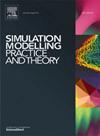你的急诊科对资金流入激增的适应能力如何?弹性增强的一个新的多维框架
IF 3.5
2区 计算机科学
Q2 COMPUTER SCIENCE, INTERDISCIPLINARY APPLICATIONS
引用次数: 0
摘要
急诊科(EDs)遇到了许多操作上的挑战、不确定性和病人突然激增,往往导致人满为患。这种过度拥挤会影响病人的治疗结果、工作人员的满意度和系统的整体功能。因此,加强这些部门面对这种不确定性的抵御能力至关重要。在本研究中,我们旨在确定导致ED过度拥挤的关键因素,并建立一个全面的分层多维弹性模型。该模型将三种拥挤评估工具(NEDOCS、EDWIN和READI)的组成部分分为可恢复性和抗逆性两大类。当我们将该方法应用于使用离散事件模拟(DES)的三个案例研究时,所提出的方法显示了有希望的结果。随后的阶段包括提供战略建议,以改善ED的性能,并作为主动预防系统故障的有价值的工具。这些建议包括增加可用资源和优化患者路径,所有这些都旨在提高急诊科有效运作的能力。我们的研究结果强调了DES模型在各种情况下预测急诊科系统性能的准确性,这些情况包括从正常患者流入情况到高患者流入情况。这种可推广的层次弹性模型有助于决策者理解系统因素,以便更好地进行资源分配和管理决策。本文章由计算机程序翻译,如有差异,请以英文原文为准。

How resilient is your emergency department to inflow surges? A novel multidimensional framework for resilience enhancement
Emergency Departments (EDs) encounter numerous operational challenges, uncertainties, and sudden surges in patient arrivals, often resulting in overcrowding. This overcrowding can impact patient outcomes, staff satisfaction, and the overall functionality of the system. Therefore, it is crucial to strengthen the resilience of these departments in the face of such uncertainties. In this study, we aim to identify the key factors contributing to ED overcrowding and develop a comprehensive hierarchical multidimensional resilience model. This model categorizes the components of three crowding assessment tools: NEDOCS, EDWIN, and READI, into two main categories, recoverability and resistance. The proposed approach demonstrates promising results as we apply it to examine three case studies using Discrete Event Simulation (DES). The subsequent phase involves providing strategic recommendations to improve the ED’s performance and serves as a valuable tool for proactive system failure prevention. These recommendations encompass augmenting available resources and optimizing patient pathways, all aimed at enhancing the ED’s ability to operate effectively. Our findings underscore the accuracy of the DES model in predicting the ED system’s performance under various conditions, ranging from normal patient influx scenarios to high patient influx scenarios. This generalizable hierarchical resilience model aids decision-makers in comprehending system factors for better resource allocation and management decisions.
求助全文
通过发布文献求助,成功后即可免费获取论文全文。
去求助
来源期刊

Simulation Modelling Practice and Theory
工程技术-计算机:跨学科应用
CiteScore
9.80
自引率
4.80%
发文量
142
审稿时长
21 days
期刊介绍:
The journal Simulation Modelling Practice and Theory provides a forum for original, high-quality papers dealing with any aspect of systems simulation and modelling.
The journal aims at being a reference and a powerful tool to all those professionally active and/or interested in the methods and applications of simulation. Submitted papers will be peer reviewed and must significantly contribute to modelling and simulation in general or use modelling and simulation in application areas.
Paper submission is solicited on:
• theoretical aspects of modelling and simulation including formal modelling, model-checking, random number generators, sensitivity analysis, variance reduction techniques, experimental design, meta-modelling, methods and algorithms for validation and verification, selection and comparison procedures etc.;
• methodology and application of modelling and simulation in any area, including computer systems, networks, real-time and embedded systems, mobile and intelligent agents, manufacturing and transportation systems, management, engineering, biomedical engineering, economics, ecology and environment, education, transaction handling, etc.;
• simulation languages and environments including those, specific to distributed computing, grid computing, high performance computers or computer networks, etc.;
• distributed and real-time simulation, simulation interoperability;
• tools for high performance computing simulation, including dedicated architectures and parallel computing.
 求助内容:
求助内容: 应助结果提醒方式:
应助结果提醒方式:


